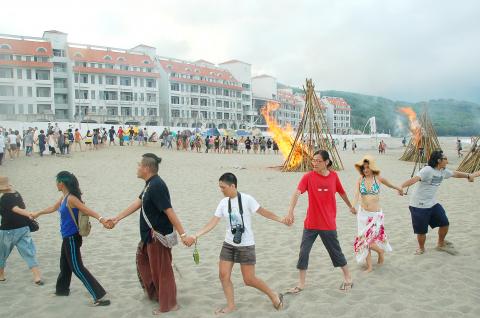After a month of continuous protests through art performances, activists and Amis Aborigines at Shanyuan Bay (杉原灣), Taitung County, who oppose the construction of a beachfront Meiliwan Resort Hotel gathered by the thousands again yesterday for a ritual ceremony at the beach.
The “besiege and fence” project by artists and activists to protest against the build-operate--transfer project was launched on June 10, followed by sit-ins and performances during the following month.
The Taitung County Government is suspected of illegally segmenting the land to avoid the need for an environmental impact assessment. After being sued by local residents and with a court ruling last year ordering a halt to construction, the county government -nevertheless authorized construction and issued licenses to the developer.

Photo: Chang Tsun-wei, Taipei Times
Construction was continuing as of press time.
About 20 environmental groups, community development organizations and civic groups gathered at the beach yesterday for a large-scale protest called “Thousands of people hold hands hohaiyan.”
Hohaiyan, a term often used in Aborigine folk songs, sounds like “shout to the ocean” in Mandarin, said Mayaw Biho (馬躍比吼), one of Taiwan’s most prolific Aboriginal documentary filmmakers. “That’s why we use it to symbolize our goal of protecting the ocean.”
The half-day protest began in the afternoon with elderly Amis, who led participants in a ritual prayer for blessings. The elders said they had lived in harmony with the ocean for generations and could not understand why the area was now being sold to private corporations.
Hand in hand, the protesters shouted that the resort hotel should be torn down and that construction that intrudes on Aborigine land rights and ignores the oceanic ecology must cease immediately.
Later on, the groups started a ritual symbolizing firing opposition toward the resort hotel.
“We want the government to know that while you are celebrating the Republic of China centenary, we are facing a bloody and tearful centenary,” Mayaw Biho said, adding that Aborigines had shared fish and the ocean with each other for centuries and would not yield the ocean to corporations.
Aborigines in eastern Taiwan are becoming increasingly deprived of their land rights, which is reminiscent of what happened to tribes in western parts of the country in the past century as economic development led to a boom in construction, Mayaw Bih said.
Continuing into the night, more than 20 groups and bands performed at the beach, including Aboriginal folk singer Panai (巴奈) and Takanow (達卡鬧), a singer of Rukai (魯凱族) and Paiwan (排灣族) ancestry.
Earlier on Friday, artists and cultural workers held a press conference to protest against what they termed inappropriate development and procedural injustice by the government benefiting corporations at the expense of residents.
“Developing tourism doesn’t mean you must exploit the land. You must get to know the local culture in depth and respect local Aborigines. Then you can decide what to do,” said a tearful Takanow, a resident near Sansiantai (三仙台), which is also threatened by construction.
“I came to Taiwan 15 years ago and I love Taiwan. However, do you think I like Taiwan because there are huge resort hotels everywhere? No. I love Taiwan because of the unique natural environment and unique Aboriginal cultures,” musician and environmental activist Matthew Lien said.

US climber Alex Honnold is to attempt to scale Taipei 101 without a rope and harness in a live Netflix special on Jan. 24, the streaming platform announced on Wednesday. Accounting for the time difference, the two-hour broadcast of Honnold’s climb, called Skyscraper Live, is to air on Jan. 23 in the US, Netflix said in a statement. Honnold, 40, was the first person ever to free solo climb the 900m El Capitan rock formation in Yosemite National Park — a feat that was recorded and later made into the 2018 documentary film Free Solo. Netflix previewed Skyscraper Live in October, after videos

Starting on Jan. 1, YouBike riders must have insurance to use the service, and a six-month trial of NT$5 coupons under certain conditions would be implemented to balance bike shortages, a joint statement from transportation departments across Taipei, New Taipei City and Taoyuan announced yesterday. The rental bike system operator said that coupons would be offered to riders to rent bikes from full stations, for riders who take out an electric-assisted bike from a full station, and for riders who return a bike to an empty station. All riders with YouBike accounts are automatically eligible for the program, and each membership account

NUMBERS IMBALANCE: More than 4 million Taiwanese have visited China this year, while only about half a million Chinese have visited here Beijing has yet to respond to Taiwan’s requests for negotiation over matters related to the recovery of cross-strait tourism, the Tourism Administration said yesterday. Taiwan’s tourism authority issued the statement after Chinese-language daily the China Times reported yesterday that the government’s policy of banning group tours to China does not stop Taiwanese from visiting the country. As of October, more than 4.2 million had traveled to China this year, exceeding last year. Beijing estimated the number of Taiwanese tourists in China could reach 4.5 million this year. By contrast, only 500,000 Chinese tourists are expected in Taiwan, the report said. The report

Temperatures are forecast to drop steadily as a continental cold air mass moves across Taiwan, with some areas also likely to see heavy rainfall, the Central Weather Administration (CWA) said. From today through early tomorrow, a cold air mass would keep temperatures low across central and northern Taiwan, and the eastern half of Taiwan proper, with isolated brief showers forecast along Keelung’s north coast, Taipei and New Taipei City’s mountainous areas and eastern Taiwan, it said. Lows of 11°C to 15°C are forecast in central and northern Taiwan, Yilan County, and the outlying Kinmen and Lienchiang (Matsu) counties, and 14°C to 17°C